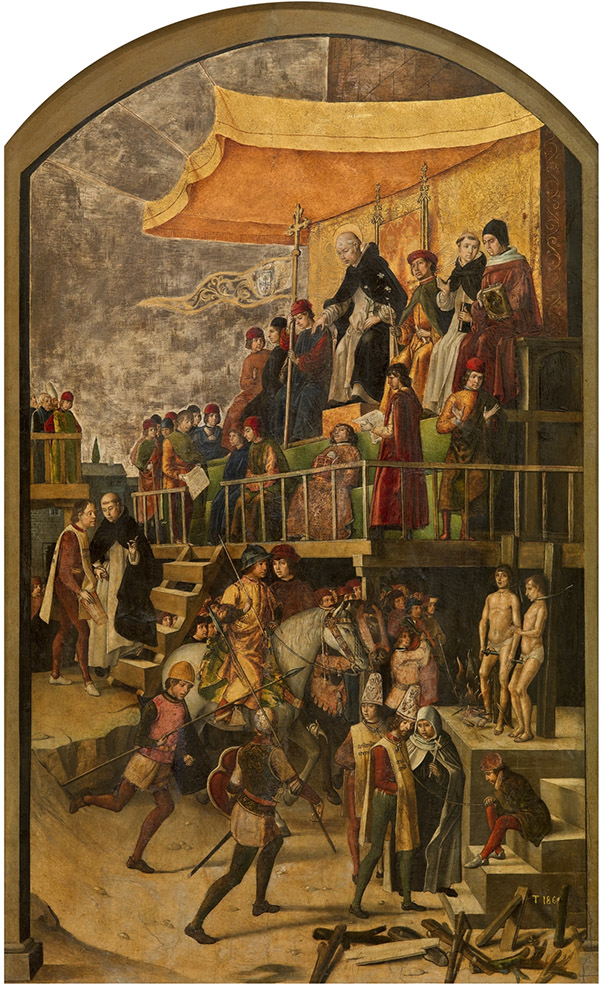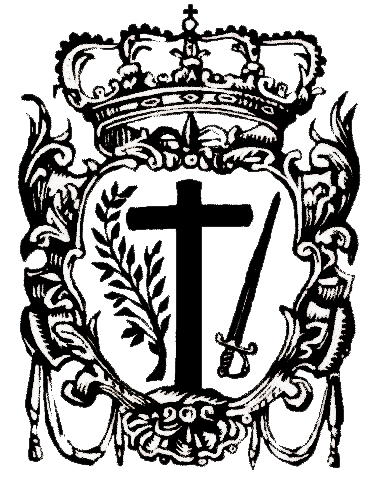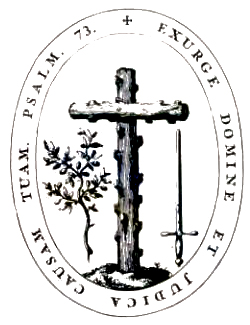THE BULL
On May 15,1252 Pope Innocent IV issued Bull AD EXTIRPANDA. It became the classic in inquisitorial procedure. It provides:
1. that anyone may seize a heretic and despoil him of his property;
2. that every magistrate shall appoint an inquisitorial commission, whose salaries are to be paid by the State;
3. that no law may be passed interfering with these Inquisitors;
4. that heretics who will not confess their heresy shall be tortured;
5. that the confiscated property of heretics shall be thus divided:
- one-third to the Inquisitors and the bishops,
- one-third to the city,
- and one-third to those who aided in the arrest and conviction.
Pope Innocent gave precise instructions to all Inquisitors to enforce the regulations throughout Europe. Eventually it was made Statute Law. The regular clergy proved reluctant, so the popes turned to the most fanatical, intolerant and narrow-minded section of the Church structure, the sundry monastic orders (monks).
The two which excelled in their infamous task were the Dominicans and the Franciscans. Armed with practically unlimited power from the popes, these Inquisitors swarmed all over Europe like theological hornets, setting up tribunals wherever they appeared.
Soon individuals, communities, nations, and indeed, the very hierarchy trembled at the mere mention of their names. Wherever they came, denunciations, accusation, treachery, perjury, torture, woe, and death resulted.

RUSSIA, GREECE, CHINA, PALESTINE, EGYPT
The hooded Inquisitors did not content themselves with establishing their court in the sundry lands of Europe. Pope Gregory IX appointed a Dominican Grand Inquisitor for the whole of Armenia and Russia. Pope Urban VI ordered the General of the Dominicans to appoint Inquisitors for Armenia, Greece and Tartary (China).
Pope Nicholas IV asked the Patriarch of Jerusalem to create Inquisitors from the mendicant friars in his land. Pope Gregory XI granted authority to the Franciscan Provincial in the Holy Land to act as Chief Inquisitor in Syria, Palestine and even Egypt.
When an Inquisitor arrived everybody was commanded, in obedience to the pope and to Mother Church, to disclose the name of anyone suspected of the slightest deviation from the Faith. The Inquisitors issued a compelling threat and a promise. A denouncer would get an indulgence of three years. Those avoiding their duty would be excommunicated.
Some denunciations were factual but many were concocted by vengeance, spite of jealousy. Those denounced, even on the flimsiest accusation or mere suspicion, would be arrested and flung directly into prison.
This usually was a common dungeon. Cold and damp, it lacked light or sanitation, and contained cut-throats, thieves, and the like. Among these the friars would plant spies to induce the accused, by pretended friendship, threats, or other methods, to admit his guilt.
If this first step proved insufficient, the suspected heretic would be chained with heavy irons and left to starve in a dark, foul hole called the durus carcer–“cruel prison.” The accused was then brought before the inquisitorial tribunal composed of friars. If he asked the names of his accusers, he was told that only his judges had the right to know their names. He had no such right.
He was asked to confess to his guilt. If he pleaded innocence, he would be sent back to prison. On a second or third appearance before the Court, if he persisted he was put to torture. The whole purpose of his trial, of course, was to force a confession of heresy.
TORTURE
If, following all the exquisite devices of torture, the heretic refused to recant or to admit his guilt, then the Inquisitors would pass capital sentence of heresy. Having done that, they would hand him over to the “secular arm,” the civil authorities.
THE INNOCENT CHURCH
To complete the macabre farce, the Holy Inquisitors would ask these same temporal powers, in the name of the Church, not to kill the poor accused. This formality was a mere legalistic device to make the Church appear innocent of the blood which was about to be spilled–or rather, burned.
The civil authorities could not heed this hypocritical plea, however, lest the Holy Inquisition fall upon them. Refusal to burn the heretic would have placed the temporal authorities themselves on trial for their lives. For heresy, of course!
Soon no one was safe from potential arrest. The spying, denunciation, and hunting down of heretics reached cleric or lay, men or women, noble or common. No one was immune from the terrorizing omnipresence of the Holy Inquisition.
This reign of Catholic terror lasted for centuries. Hundreds of thousands of men, women, and yes, even children were murdered…burned alive at the stake. Simply because they dared to disagree with the Holy Catholic Church or with her popes.
This Catholic terror officially ended less than two hundred years ago. As recently as 1762 a Protestant pastor was condemned to death in France. Why? Simply because he was a Protestant! By whom? By the Catholic Church! Yes, by that same church which now pretends to love her “dear separated brethren (Protestants).”
Indeed, in Europe torture was still enforced by all the Tribunals of the Holy Inquisition until the last century, the pope being forced to abolish it only in recent 1816.
It was Napoleon, who entered Madrid in 1808, who was to abolish the Inquisition. When the Spanish Parliament in 1813 declared it incompatible with the Constitution, the Vatican protested. Super-Catholic Ferdinand VII restored it in 1814, with the full approval of the Church. The Holy Inquisition was finally suppressed by the Liberals in July, 1834.
Yes, just SUPPRESSED. It is still alive! This same spirit still alive in Croatia in 1942 when the Catholic Ustachi mutilated hundreds of thousands of Serbian “heretics.” Also in South Vietnam in 1960 when Catholic President Diem set out to rid that country of Buddhist “heretics?”
ROMAN INQUISITION
An ecclesiastical tribunal established by Pope Gregory IX circa 1232 for the suppression of heresy. It was active chiefly in northern Italy and southern France, becoming notorious for the use of torture. In 1542 the papal Inquisition was re-established to combat Protestantism, eventually becoming an organ of papal government

SPANISH INQUISITION
The Tribunal of the Holy Office of the Inquisition (Spanish: Tribunal del Santo Oficio de la Inquisición), commonly known as the Spanish Inquisition (Inquisición española), was established in 1478 by Catholic Monarchs Ferdinand II of Aragon and Isabella I of Castile. It was intended to maintain Catholic orthodoxy in their kingdoms and to replace the Medieval Inquisition, which was under Papal control. It became the most substantive of the three different manifestations of the wider Christian Inquisition along with the Roman Inquisition and Portuguese Inquisition.
PORTUGUESE INQUISITION SEAL

The Western world were enriched with the noble practice of judicial torture, expressly employed by Holy Mother Church for the suppression of heresy, later known as Protestantism.
A SAD INQUISITOR
“In our days, there are no more rich heretics, so that princes, not seeing much money in prospect, will not put themselves to any expense; it is a pity that so salutary an institution as ours [in other words, the INQUISITION] should be so uncertain of its future. “‘
Quote= Inquisitor Eymeric de Campo 1375
